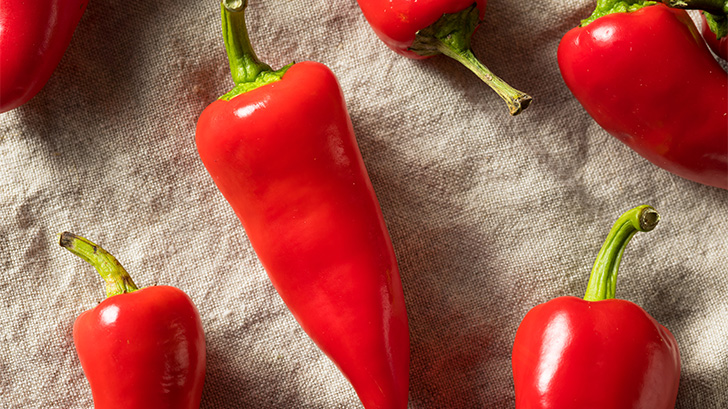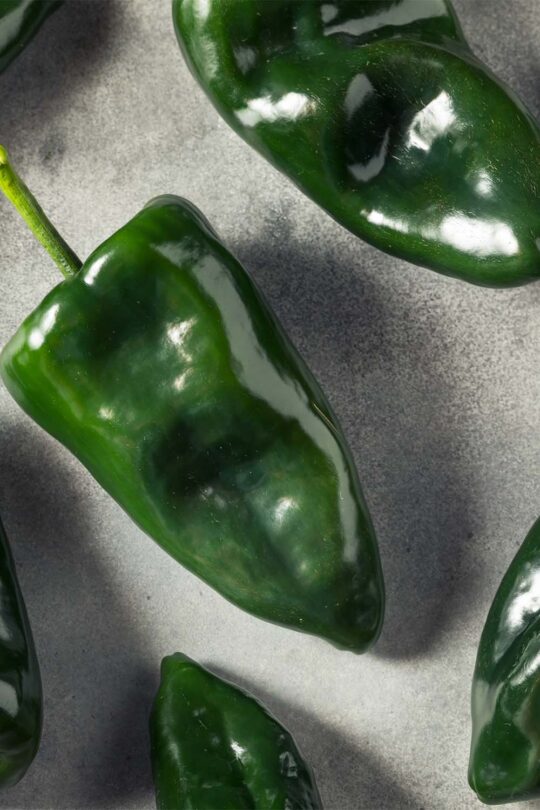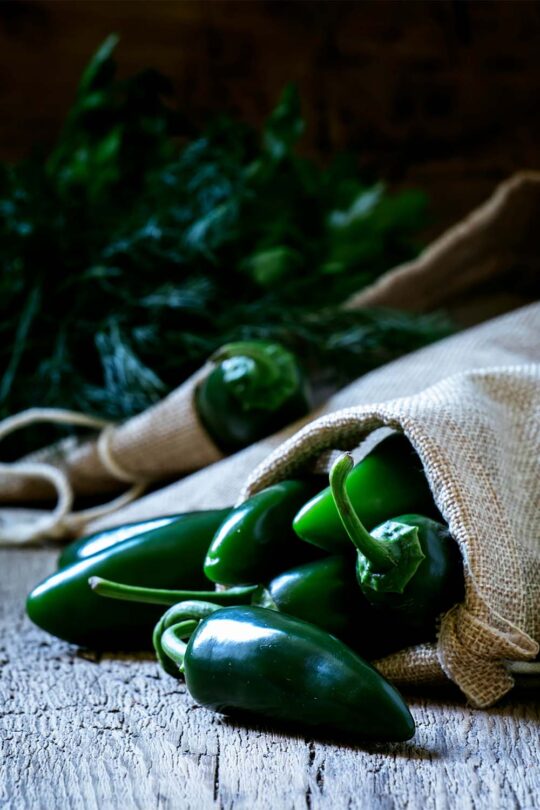The day before you have a crowd coming over is always the same day the supermarket is randomly out of a certain red chili pepper that’s the star ingredient in your tacos. That’s also the day you need to know more about the best Fresno chili substitutes.
We got you. Here’s a closer look at the Fresno chili and ingredients you can use as substitutes.
What’s a fresno chili?
The Fresno chili is a mildly spicy pepper named after — you guessed it — Fresno, California. The bright red chili is relatively easy to grow and so is widely accessible.

In looks, the Fresno chili is small and bright red when mature. An unripened Fresno chili will be green, resembling a small jalapeno.
You can expect Fresno chilies to be about 2 to 4 inches long — they have a conical shape with pointed tips. The skin is glossy, thin, and slightly bumpy. The interior of the pepper contains edible white membranes and tiny seeds that are also edible. As is usual with chilies, you can remove the seeds for a milder flavor.
What does Fresno chili taste like?
If you need to substitute for Fresno chili, it helps to know what this pepper tastes like.
Fresno chilies are fruity and earthy with hints of citrus and grassiness. The flavor is quite bright when raw. Cooked, this chili adds a pleasant heat and mild complexity without being too spicy or overpowering. It’s a popular ingredient that brings flavor and mild spice to tacos, enchiladas, burritos, and salsa.
Fresno chilies and the Scoville scale
The Scoville scale is a method of ranking the spice level of chilies. The compound behind a chili’s spiciness is capsaicin. The Scoville scale measures how much capsaicin is in each type of pepper, so you can compare and rank them in terms of heat.
I can tell you that the Fresno chili is moderate in spice. But “moderate” is a subjective word. It means one thing to me and something very different to my husband, who doesn’t like spicy food. That’s why the Scoville scale is so useful. It’s an objective means of describing how hot a pepper really is.
The table below shows the Scoville Heat Unit measurement of different chili varieties. You can see the Fresno pepper is low on the scale relative to, say, the Serrano pepper.
| Pepper | Scoville Heat Units (SHU) |
| Pure capsaicin | 16,000,000 |
| Scotch bonnet | 350,000 |
| Tabasco | 50,000 |
| Serrano | 23,000 |
| Jalapeno | 10,000 |
| Fresno chili | 6,250 |
| Poblano | 2,000 |
| Pepperocini | 900 |
| Bell pepper | 0 |
It’s important to know that the numbers above are averages. An individual pepper can be much hotter or milder than its family average. It is possible to get a super-hot Fresno chili or an ultra-mild Jalapeno, for example.
Substitutions for fresno chilies
In theory, you could swap in any chili for red Fresno peppers. Then, if you want to moderate or amplify the effect the substitution has on your dish, simply adjust the amount of chili you use. As an extreme example, say you need a Fresno chili but you only have a Scotch bonnet on hand. You’d use a tiny fraction of the Scotch bonnet in place of the Fresno. Your dish may still be much hotter, but you get the idea.
Still, you want your tacos to be edible without a sip of milk between each bite right? So maybe don’t use a Scotch bonnet in recipes that call for Fresno chili. Try these alternatives instead.
Best of the Fresno chili substitutes: Poblano pepper mixed with Jalapeno pepper
Many sources online will tell you the Jalapeno is the best Fresno chili substitute. I don’t agree. The Jalapeno is measurably hotter than the Fresno pepper. And that puts you at risk of over-spicing and overpowering your dish.
On the other hand, the Poblano pepper is milder than the Fresno. So why not team up Jalapeno and Poblano to stand in for the Fresno?
Use half Poblano and half Jalapeno when you don’t have a Fresno. As is best practice anytime you’re using chilies, start with less than what the recipe recommends. Then add more to suit your taste. That way, you don’t ruin your dish because you randomly had a super-hot Poblano.
More about Poblanos

Poblano peppers have a mild heat and a slightly smoky flavor that adds complexity to food. When eaten raw, they have a crisp texture and sweet, earthy flavor. When cooked, the sweetness intensifies, but the smokiness remains.
It is common to find Poblano peppers roasted, stuffed, or diced and used for tacos or burritos. The rich flavor of the peppers pairs well with cheese, onions, garlic, tomatoes, and other vegetables. The subtle heat of Poblanos makes them a nice choice for adding flavor without risking too much spice.
More about Jalapenos

Jalapeno peppers have a delicious and spicy flavor that can add a kick to any dish. They are often eaten raw, but they can also be grilled, boiled, or fried. The flavor of jalapeno peppers is earthy and slightly sweet with a kick of heat.
The heat level of Jalapenos varies depending on the variety and where they are grown. Some may have more or less heat than others. If you prefer a milder taste, you can remove the seeds for less spice.
Simplest Fresno substitute: Jalapeno, but less of it
Your next Fresno chili alternative is to use Jalapeno peppers, but a smaller amount than the recipe calls for. Start with one-third of the recommended measurement and add more to taste.
Fresno chili substitutes if you don’t like spice
If you don’t like spicy food, don’t bother with the Jalapeno. For any recipe that calls for a fresh Fresno pepper, use a fresh bell pepper or a fresh Poblano. The bell pepper has no spice, but its flavor works nicely in any Mexican dish. Poblano adds just a touch of heat, but not as much as the Fresno.
Powdered and bottled Fresno chile pepper substitutes
For those days when you’re mid-recipe before you realize you don’t have all the ingredients…here are a few pantry items you can use to substitute for Fresno peppers.
Chili powder or Chipotle chili powder
If you’re in a jam, swap in a shake of chili powder. When subbing a powdered spice for a fresh ingredient, always use a smaller measurement. The powder will be more intense in flavor, so you need less of it. This is because fresh ingredients have a high water content, which takes up space and dilutes the flavor.
So start with a pinch of chili powder and add more to suit your taste.
Paprika
Paprika is less spicy than chili powder, but delivers a wonderful smoky flavor that works well in Mexican cuisine. Paprika is not spicy, so it’s a less risky substitute vs. chili powder.
You could use paprika in the dish and then make Tabasco available for anyone who wants more heat.
Tabasco
Tabasco sauce is made from Tabasco peppers, which are much higher on the Scoville spice scale than Fresno peppers. The pepper is diluted with vinegar in this form, but still. Start with a dash of it in your dish, and then add more to taste.
Cayenne pepper
Cayenne pepper has much more heat than standard chili powder. On the spice scale, it’s close to the Tabasco pepper. Keep that in mind if you want to use it as a substitute. Start with a pinch of it.
Canned Chipotle peppers
Chipotle peppers are roasted Jalapenos, usually canned in a spicy, smoky sauce. These have a wonderful and complex flavor, but they can also be very spicy. As with Tabasco and cayenne, a little goes a long way.
What about Serrano peppers?
I don’t recommend using Serrano peppers as a Fresno alternative. Serranos are four times hotter than Fresno peppers. With that spice level, it’s too easy to ruin your dish. (I once made a stir-fry with Serranos and it was so hot, I couldn’t eat it.) You’re better off using a bit of chili powder or a fresh Poblano.
Find your own best Fresno pepper dupe
You can also experiment mixing and matching different peppers to find the combo you like best. Remember, too, that you can moderate the spice level of any pepper by removing the seeds and/or roasting it.
A roasted pepper will be sweeter and milder than a fresh one. You obviously don’t want to roast your substitute pepper if the dish demands crunch. But roasting is an option if you’re making something where texture is secondary to flavor and spice.